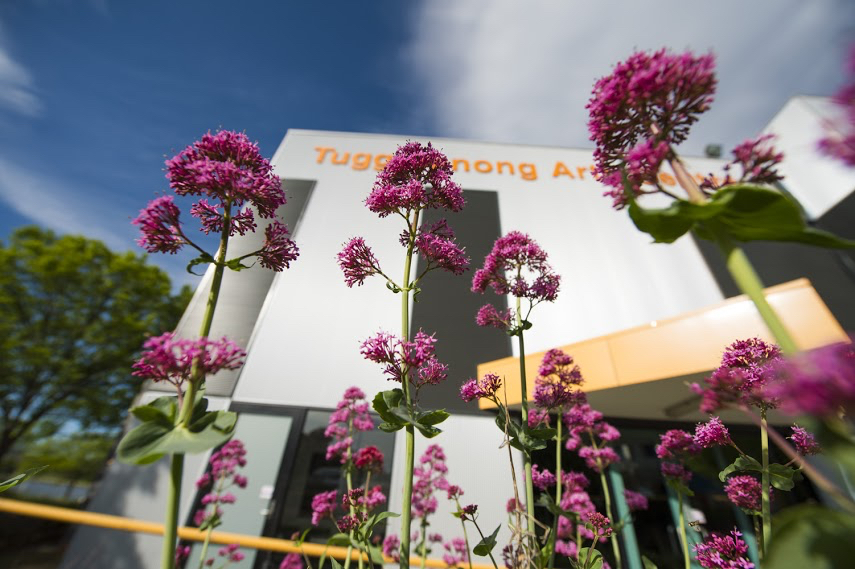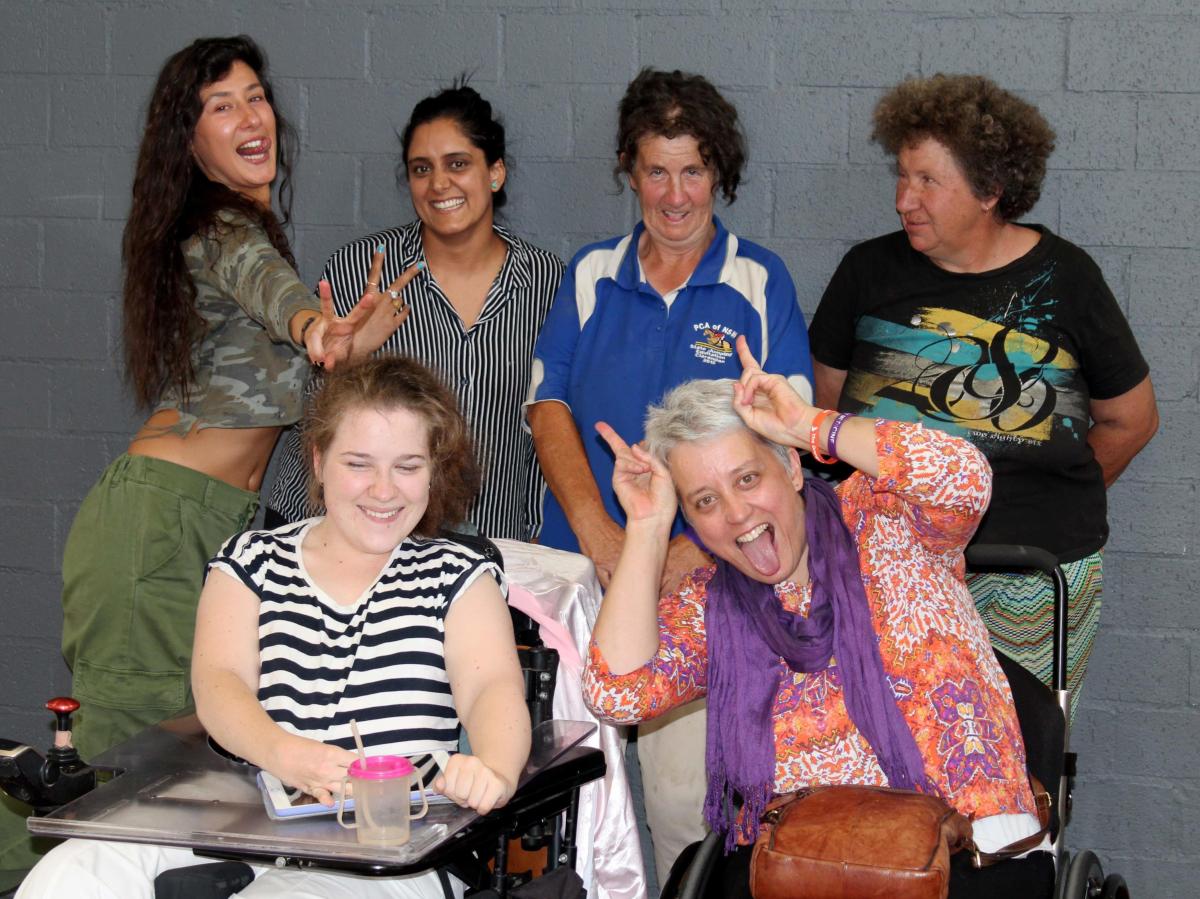Didem Caia and workshop participants. Image supplied.
As artists we have two main tools at our disposal when telling human stories: action and motivation. Essentially, what do people do, and why do they do it? For the last eight years I’ve been creating theatre from a grassroots level, where the goal of a production is on the horizon but the stories and ideas are unknown until a series of workshops slowly unravels the commonalities and disconnections between participants.
My latest project, Mono|Stereo, is a six-month theatre development, working with local residents in Tuggeranong in the ACT, to see and hear their flashes of fixation, anger, surprise, elation and fear as we explore what sets them apart and brings them together. The idea burst forth from a series of conversations with Tuggeranong Arts Centre’s (TAC) CEO, Rauny Worm, discussing voice, nuance and the subtle sensitivities of humans. I had recently spent a couple of years devising theatre collaboratively with communities, having cultivated similar projects in Victoria, when Rauny and I began to discuss the benefits and possibilities of bringing the process to Canberra.
My artistic values have always involved community, creativity and connection. The opportunity to work with TAC on this project is another step in innovating the form and process of creating live performance, whilst also unveiling the voices and stories of an eclectic mix of personalities. When arts organisations invest in the cultivation of community through arts practise, it inevitably opens the door for new streams of people and stories to begin entering, severing the dominant culture and rebuilding a richer and much more expansive view of Australian life.
How do we determine the participants?
One of the outcomes of my discussions with TAC was the idea to cultivate stories from those who self-identify as outside or other to a suggested mainstream culture of the Tuggeranong region. This involved a dialogue with project producer, Aidan Delaney, to determine the participants and what would constitute the greatest success in terms of differences amongst voice, class, experience, ableism, age, and gender. For me, it was important to have a wide scope of participants to break open the atom of collectivism and elevate the connecting features between stories and identities.
Fortunately, TAC is a hub for cultural diversity and has established strong relationships with many local audience members, artists and residents because the philosophy of inclusion is deeply embedded within the organisation’s values. Aidan and I discussed the stories, identities and backgrounds of around 6-8 potential participants who we then had initial meetings with in November 2018, before the first round of workshops in February 2019.
These intimate meetings are what playwrights live for! The ability to sit down and listen to somebody for the first time, gathering the nuance and details of speech and the rigour of their personal passion, is enchanting. These meetings were a way of building trust, communication and friendship. The project dedicated this time in order to purposefully position each participant to hear exactly how I would be gathering and using material, and to allay any fears or discomfort. Fortunately, everyone who I sat down with was buoyed to be part of this embryonic stage.

Tuggeranong Arts Centre. Image supplied.
What lies beneath the surface?
Every individual is rich with difference, experience, history and longing. There are myriad ways that one person can differ from another. But to spend a concentrated period of time teasing out the subtle nuances of these differences, which reach far deeper than surface, is what I’m most interested in. For this sort of depth, time is needed.
In February, we completed our first two weekends of workshops. I had done my preparation to structure the six-hour days, which would include conversation, writing exercises and group activities that would evoke conversation between participants. But as always, the structure becomes malleable once a group of people come together. Given that we had laid our ground work in November and many of our participants had existing relationships with TAC, the fluidity of the conversations got off to a roaring start without me having to break through any silence.
The first workshop dealt deeply with story, history and place. The group of six became a commune where the eldest is 60 and the youngest is 21. Between us there are differences between physical ability, occupations, family structures, cultures, languages and skills such as writing, painting, and farming. My method is to choose a collection of elements that don’t discriminate – such as family, home, childhood, trauma. Every one of us, no matter colour, culture or creed have had experiences with the bigger elements of the human condition and my job is to get to the bottom of it so that I can be the vessel to help express their stories. From the exercises, emerges a quagmire of material that I then shape to resemble the best version of what was gathered from the participants themselves.
The common theme of our first series of workshops was the idea that our environment, earth and land is a sacred place that has its own identity and set of emotions. We spent time discussing the atrocities done to the environment and the importance our sense of connection to the environment. Against the backdrop of this environmental war was the emergence of many interpersonal wars that we all face moment to moment.
Swimming up mainstream
What many of our organisations, individual artists and leaders are trying to deconstruct are the ways in which story and experiences have been steeped in traditions that leave out valuable members of our society, whose contributions would inevitably create a richer quilt of representation. Many of us are working tirelessly to bring the scales of justice and representation to a balance.
What Mono|Stereo is aiming for is the wider representation of body, age, class and language as well as form and modes of storytelling, to make new discoveries about the ways theatre experience can be presented that makes sense for us. Not all of our participants have the same facilities with language, speech and expression, so my job is to widen the scope of how I receive story in the first place. This is why I don’t work in a singular way, but seek to bring in different styles, which are fluid and conjure expression in many ways so that everybody can have a chance to be heard.
What are we fighting for?
We are new at coming to terms with the inherent discrimination and violation of many groups in society, let alone exploring these stories through the medium of theatre. Theatre is historically about much more than an entertaining past time. It’s the platform of the people.
By continuing to create access, new forms of development and an openness to experiment, we can keep paving the way for the stories yet to be told, and the people yet to be heard. There are members of society who are literally fighting to be heard. Members who exist outside of the dominant culture due to systemic conventions that have determined what theatre should be, and instead of remaining comfortable about that, I am proud that many artists are working to tackle these issues.
The arts is one such way that we can create true inclusion, because art in its totality, is about the excavation of what it means to be human in a world that is filled with obstacles, injustice and suffering.





